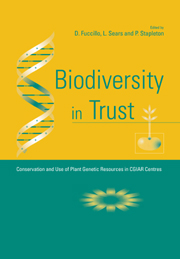Book contents
- Frontmatter
- Contents
- Preface
- Contributors
- Acronyms
- Chapter 1 Cassava
- Chapter 2 The Potato
- Chapter 3 Sweetpotato
- Chapter 4 Other Andean Roots and Tubers
- Chapter 5 Yams
- Chapter 6 Banana and Plantain
- Chapter 7 Cowpea
- Chapter 8 Chickpea
- Chapter 9 Groundnut
- Chapter 10 Lentil
- Chapter 11 Phaseolus Beans
- Chapter 12 Pigeonpea
- Chapter 13 Faba Bean
- Chapter 14 Soyabean
- Chapter 15 Barley
- Chapter 16 Maize, Tripsacum and Teosinte
- Chapter 17 Pearl Millet
- Chapter 18 Small Millets
- Chapter 19 Rice
- Chapter 20 Sorghum
- Chapter 21 Wheat
- Chapter 22 Forages
- Index
Chapter 2 - The Potato
Published online by Cambridge University Press: 22 September 2009
- Frontmatter
- Contents
- Preface
- Contributors
- Acronyms
- Chapter 1 Cassava
- Chapter 2 The Potato
- Chapter 3 Sweetpotato
- Chapter 4 Other Andean Roots and Tubers
- Chapter 5 Yams
- Chapter 6 Banana and Plantain
- Chapter 7 Cowpea
- Chapter 8 Chickpea
- Chapter 9 Groundnut
- Chapter 10 Lentil
- Chapter 11 Phaseolus Beans
- Chapter 12 Pigeonpea
- Chapter 13 Faba Bean
- Chapter 14 Soyabean
- Chapter 15 Barley
- Chapter 16 Maize, Tripsacum and Teosinte
- Chapter 17 Pearl Millet
- Chapter 18 Small Millets
- Chapter 19 Rice
- Chapter 20 Sorghum
- Chapter 21 Wheat
- Chapter 22 Forages
- Index
Summary
The potato that is grown worldwide as one of the major food crops belongs to a single species, Solanum tuberosum L. In the English language, another common name is Irish potato. The word potato derives from the Spanish word patata, which is also the name for this crop in Portuguese and Italian. The name in French is pomme de terre. Its most common name in the Spanish spoken in Latin America is papa, a word derived from Quechua, the language of the Incas.
Global potato production is around 260 million t on an area of about 18 million ha. In recent years, potato production has spread from its traditional mountainous environment into warmer, drier areas such as Peru's coastal valleys, the plains of India, Bangladesh and Pakistan, and the irrigated oases of North Africa. It is also spreading into warm, humid zones (Horton 1988).
BOTANY AND DISTRIBUTION
Cultivated species and all their wild relatives are classified in the family Solanaceae, genus Solanum, subgenus Potatoe, section Petota (formerly Tuberarium), and subsection Potatoe (formerly Hyperbasarthrum) (Hawkes 1990). In addition to S. tuberosum, Latin America houses seven other cultivated species with ploidy levels from diploid (2n=2x=24) to pentaploid (2n=5x=60) (see Table 2.1).
Origin, Distribution and Diffusion
The potato undoubtedly originated in South America and was domesticated in the highlands of the central Andes, probably between central Peru and central Bolivia. It was cultivated as far back as 7000 years before present (BP), based on archaeological evidence mainly from coastal Peruvian pre-Inca cultures.
- Type
- Chapter
- Information
- Biodiversity in TrustConservation and Use of Plant Genetic Resources in CGIAR Centres, pp. 21 - 28Publisher: Cambridge University PressPrint publication year: 1997
- 18
- Cited by



